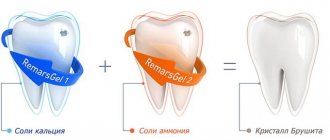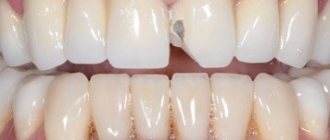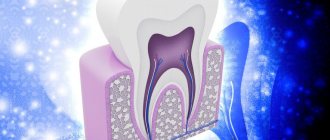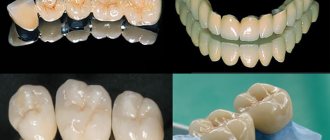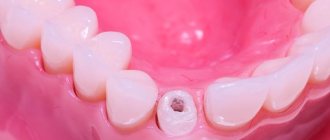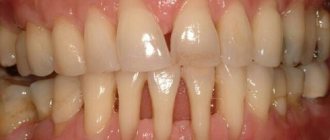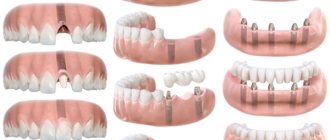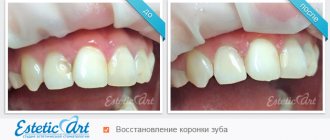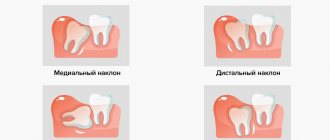Any aesthetic imperfections in the teeth require restoration. In dentistry, this direction is called aesthetic restoration. It allows you to restore the tooth, interdental spaces, and natural color so that it is not noticeable when you smile. Also one of the tasks: to restore the normal function of the teeth so that the entire process of chewing food occurs correctly. This is important to ensure that pathologies in the joint and gastrointestinal tract do not occur in the future.
Currently, there are many materials on the dental market that allow for artistic restoration, and advanced techniques have been developed for doctors to work in this field.
Indications for restoration of anterior teeth
Aesthetic restoration is required in several cases:
- If there are chips or cracks in the enamel.
- When the coronal part is destroyed as a result of injury or advanced caries.
- If there are unsightly gaps between the teeth.
- When teeth darken after endodontic treatment or taking certain medications.
- With pathological abrasion of enamel.
- If there is a slight curvature of the dentition.
- If the shape of the teeth does not suit the patient.
- If there are unsightly old fillings on the front surface of the teeth.
Preparation for restoration: stages
If the patient has indications for such treatment, then:
- Examination and consultation with an orthopedic doctor who will help you choose the necessary recovery option.
- Carrying out additional diagnostics - computed tomography, which will allow us to examine all structures in detail and identify contraindications to this or that type of restoration.
- Professional oral hygiene performed by a dental hygienist. It consists of removing plaque, stones from the surface of the enamel, eliminating bleeding gums, etc.
- Treatment: sanitation of the oral cavity is necessary in order to eliminate foci of infection and caries.
- Whitening can be carried out before the restoration, since if it is carried out after, the color of the bleached teeth will not match the previously carried out restoration.
- The Vita scale is used: the orthopedic surgeon determines the color of the teeth.
Restoration methods
The approach to restoring anterior teeth depends on the situation. Basic methods: can be divided into direct and indirect.
- The first category involves applying the material directly to the tooth, in the dentist's chair. The composite is applied layer by layer, the structure of the internal tissues of the tooth is imitated as much as possible, and colors are selected.
- Indirect restoration uses dentures made in a dental laboratory. Depending on the degree of tooth destruction and the purpose of restoration, microprostheses or full-fledged orthopedic structures can be used.
Basic myths about restoration
Myth No. 1. Children do not need restoration, it is only for adults.
When parents learn during a consultation with a pediatric dentist that their child’s baby teeth need to be treated, they do not attach much importance to it. They have the opinion that baby teeth are not important because they will fall out anyway. But it's not right. The fact is that in childhood the jaws grow and the bite is formed, which depends on what kind of fillings are on the teeth.
Artistic restoration allows you to recreate the natural anatomy of the teeth and dense interdental spaces. Thanks to this, the correct formation of the bite occurs. In addition, the condition of the filling affects chewing food. If the filling is flat, without pits and tubercles, then the child will not chew food, but simply grind it. Accordingly, problems with the gastrointestinal tract will arise. Therefore, even in childhood, artistic restoration must be carried out on baby teeth.
Myth No. 2. Restoration with composites is pointless, it’s just a filling, it will fall out, it’s safer to install crowns.
Each clinical situation has its own specific indications. It is possible to determine which restoration to carry out only after diagnosis and examination. If there is a minor defect on a living tooth, then a crown is not necessary.
If the tooth is severely damaged or dead, then the doctor suggests the patient get a crown. It is worth noting that composite restoration has a number of advantages:
- the tooth is ground minimally;
- carried out sparingly and for minor aesthetic defects;
- the doctor follows a certain technology for applying the filling material, which contributes to the high strength of the filling and reliable fixation;
- the material smoothly blends into its own enamel and dentin without any gaps. Strong adhesion to tissues prevents the development of secondary caries;
- profitable: the price is lower than that of orthopedic structures.
Consequently, a crown is not placed in all cases and there are certain indications for it.
Myth No. 3. To make the price more expensive, they simply came up with the word “restoration”, but in reality it is an ordinary filling.
When a regular filling is placed on a tooth, it performs only one function: closing the carious cavity. When aesthetic restoration is carried out, they achieve high aesthetic results, restoration of the full anatomical form, as well as function. The tooth must chew food fully, have dimples and tubercles. A regular filling is not capable of this. This is where the difference in cost comes from. To avoid complications from the temporomandibular joint and gastrointestinal tract, it is always better to choose artistic restoration.
In addition, every dentist can place a regular filling, but only a highly qualified doctor with many years of experience can perform a restoration.
Direct restoration
Composite materials are used for this. The procedure is performed in the dentist's chair and does not require taking impressions or waiting. As a rule, the method is used after removing tissue affected by caries to restore the integrity and original appearance of the tooth. The main disadvantage of direct restoration is the loss of appearance after a relatively short time. The filling material is susceptible to food staining and is quite fragile. Aesthetics also suffer, since composite materials do not provide the necessary transparency and shine inherent in natural healthy teeth.
When it comes to composite veneers, the disadvantages include difficulties with fit in the gum area. Direct restoration cannot cope with darkening of teeth, gaps, and crookedness.
If there is nothing left of the tooth
It happens that people put off visiting a doctor for so long that only emptiness remains in place of the crumbling unit. If the roots are preserved, a crown can be installed. If they are absent or are in an unsatisfactory condition for prosthetics, the patient is offered implantation. This is a dental operation during which a titanium pin is implanted into the jaw bone. After its healing, an abutment and an artificial crown are installed on top.
If the client refuses implantation, a dental bridge can be installed. But then you will have to depulp and file the healthy teeth located on both sides of the empty space.
Treat crumbling teeth on time, then you won’t have to spend a lot of time, money and effort on restoring them. At the first symptoms of a destructive process, contact your dentist.
Restoration of front teeth with crowns
Crowns for the front teeth are the most durable restoration option. They allow you to restore even severely damaged teeth, eliminate curvatures, gaps, and solve the problem of darkening. The crown is installed on a prepared tooth, ground to the desired shape, or on a stump insert installed in the root canal. Ceramic or zirconium crowns are mainly used for the front part of the dental arch. They allow you to achieve excellent aesthetic results, while the dentures are strong and durable.
Types of damage and their complexity
All mechanical injuries can be divided into:
1. Dislocations are a fairly complex injury, which is characterized by the displacement of one tooth relative to the others.
2. Fractures are severe types of injuries. These include: cracks in the coronal part, chipped enamel, and root fractures. The method of treating and eliminating the problem depends on the specific case.
3. Bruises are the mildest type of all injuries. It is characterized by minor tissue damage, without displacement.
The main causes of damage are:
- caries;
— thinning of tooth enamel due to problems (diseases) in the human body, and as a consequence deformation of the tooth shape;
- large and sudden load on the front part of the jaw;
- direct blow or careless handling.
How is restoration carried out?
First of all, the teeth are prepared, caries is eliminated, endodontic treatment is carried out, and if necessary, professional cleaning is carried out. Restoration with filling material is carried out immediately, in one visit. If you plan to install veneers or crowns, the teeth are ground down. After the surface is prepared, impressions are taken and temporary dentures are installed for the patient. When the permanent structures are ready, they are installed in their places.
Care after restoration requires maintaining a high level of hygiene, as well as regular preventive examinations.
Author:
Mayorov Andrey Mikhailovich
Specialization:
orthopedic dentistry, dental prosthetics, implant installation
Installation of veneers
Have you heard about thin overlays that create the effect of a Hollywood smile? This is the merit of veneers. They are made of ceramic or porcelain, have high aesthetic values, look natural in the mouth and do not cause discomfort after installation. It would seem an ideal option for the front teeth. But there are still some disadvantages - high cost and the need to grind teeth. By the way, veneers can be fixed not only to the entire dentition, but also exclusively to problem areas. With their help, you can disguise chips and cracks, uneven shade of enamel and other aesthetic imperfections.
Which crown is best for a defect in the smile area?
- all-ceramic,
- from zirconium dioxide.
It is worth giving preference to designs made from these materials simply because they look very aesthetically pleasing and accurately imitate the color and shine of natural enamel. They are not susceptible to pigmentation from food, and with good hygienic care they retain their excellent appearance for many years of use. By the way, zirconium dioxide crowns have an impressive service life - 15 years or more.
But it is better not to choose metal-ceramics for the front teeth. Firstly, the metal will show through the top layer of ceramic. Secondly, the metal, when interacting with saliva, oxidizes over time, so an unpleasant bluish tint will soon appear at the border of the crown and the mucosa.
You need to understand that a front tooth can break in different ways. If the scale of the problem is insignificant, for example, only the enamel is chipped, then doctors may suggest hiding the defect with the help of dental overlays - veneers or lumineers. Or carry out artistic extensions. But sometimes the situation requires removal, for example, if a longitudinal or oblique fracture/crack or suppuration at the root appears as a result of an injury. And then the recovery options will be completely different - you will need to install a crown with a pin/stump inlay, or carry out implantation altogether.
Using Lumineers
It acts as an analogue to veneers, but has a wider range of advantages, for example, the absence of turning. For more reliable fixation, it is enough to carry out surface grinding of the enamel. Also, these dental products are thinner, which increases the level of aesthetics and naturalness. They cost about 1.5 times more than veneers, but the result is worth it. Installation is very fast. The first session includes examination and sanitation of the oral cavity, as well as taking impressions. At the second session, lumineers are installed.
Why is it necessary to restore teeth?
Many people wonder how to hide the absence of a front tooth, but when a chewing tooth disappears, not everyone immediately tries to visit the dentist. For what? He is invisible when talking and smiling. Right? However, thinking in this way is fundamentally wrong. Any element of the series carries a certain load and is responsible for the functionality of the maxillofacial apparatus as a whole. When a person has all intact and healthy teeth, then this is, first of all, an indicator of health, and only then aesthetics.
Therefore, if even one element of a row is missing, you need to think not only about how to hide this fact from others, but also about how to restore the defect for the proper functioning of the entire jaw system and in order to prevent serious health problems. Remember that everything starts small. If you fail to carry out prosthetics on one unit in a timely manner, you risk the following problems:
- pain and discomfort when chewing food: because of this, you begin to prefer soft foods or those that you can eat (while putting a taboo on your favorite foods),
- impossibility of high-quality processing of food in the oral cavity: once it enters the stomach in an insufficiently chewed form, it is poorly absorbed, causing gastrointestinal pathologies,
- facial asymmetry: this process occurs gradually. So, at first you chew mainly on one side of the jaw, where it is more comfortable for you. Then muscle memory kicks in, leading to deformations and disruption of not only the aesthetics of the smile, but also the face, early aging, the appearance of wrinkles,
- early loss of other teeth: if you are not in a hurry to replace one lost unit with prosthetics, then the load intended for it begins to be distributed among its “neighbors.” Plus, they tend to take up empty space, bend over, can begin to wobble, collapse, and in the end you will simply lose them,
- atrophy of bone structures: the tissues in the area of the defect gradually become thinner, because they do not have the necessary load on them, they stop receiving nutrition. By delaying the moment of prosthetics, you run the risk of encountering difficulties in the future when not all possible treatment methods are suitable, but only a few.
Next, we will consider various situations in which it may be necessary to hide a defect, and options for solving the problem.
Removable temporary solutions
These are again the immediate “butterfly” prostheses that we have already discussed above. They are the best suited for the role of temporary ones. This type of design is also suitable in preparation for implantation, during tissue healing after osteoplastic surgery. Or during the healing of the implant, in particular, when the treatment is carried out according to the classical two-stage protocol and the artificial root cannot be loaded until its successful osseointegration occurs, i.e. engraftment into bone.


